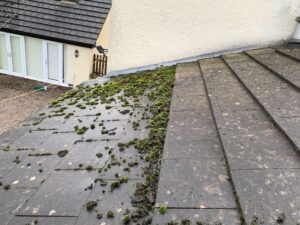Moss growth on flat roofs is a common issue, especially in damp and shaded areas. While moss may seem harmless, it can cause significant damage to roofing materials, leading to leaks, structural weaknesses, and costly repairs. Proper moss removal techniques not only extend the lifespan of a flat roof but also help maintain its aesthetic appeal and functionality. Understanding the causes of moss growth and the best removal methods can ensure a long-lasting and well-maintained roof.

Understanding Why Moss Grows on Flat Roofs
Moss thrives in moist environments where there is little to no direct sunlight. Flat roofs are particularly susceptible due to their tendency to retain water and accumulate debris such as leaves and dirt. These conditions create the perfect habitat for moss to grow and spread rapidly. Once moss establishes itself, it can trap even more moisture, accelerating the deterioration of roofing materials.
In areas with high humidity or frequent rainfall, moss growth is a persistent issue. If left untreated, moss can infiltrate cracks, lift roofing materials, and contribute to water pooling, which can lead to structural damage. Preventative measures and proper removal techniques are essential to maintaining the integrity of a flat roof.
Manual Moss Removal Methods
One of the simplest ways to remove moss from a flat roof is through manual cleaning. This method requires some physical effort but is effective in eliminating moss without damaging the roof’s surface. Using a stiff brush or a broom, moss can be gently scrubbed off the surface. It is crucial to avoid excessive force, as aggressive scrubbing may harm the roofing material.
Another approach is using a pressure washer, but this must be done with caution. High-pressure water can dislodge roofing materials or force water into the building structure, leading to leaks. If a pressure washer is used, it should be set to a low pressure, and the spray should be directed at a downward angle to minimize damage. After removal, rinsing the roof with clean water helps wash away any remaining moss particles.
Chemical Moss Removal Treatments
Chemical treatments are another effective way to eliminate moss and prevent its regrowth. Moss-killing solutions, such as zinc sulfate, copper sulfate, or specialized moss removers, are available for flat roof applications. These treatments are typically applied as a spray and left to work over time, breaking down moss and inhibiting further growth.
While chemical solutions are efficient, it is important to choose products that are safe for the roofing material and the surrounding environment. Harsh chemicals may cause roof damage or harm plants and wildlife. Eco-friendly alternatives, such as vinegar or hydrogen peroxide, can be used to kill moss without introducing harmful substances. Applying these treatments on a dry day ensures better absorption and effectiveness.
Preventative Measures to Reduce Moss Growth
Regular maintenance is key to preventing moss from returning. Keeping the roof clean and free of debris reduces the likelihood of moss growth. Regularly removing leaves, dirt, and stagnant water prevents the conditions that encourage moss to thrive.
Improving roof drainage can also minimize moisture accumulation. Ensuring that gutters and downspouts are clear and functioning properly helps direct water away from the roof. In some cases, installing a slight slope or drainage channels on a flat roof can help prevent water pooling, reducing the risk of moss formation.
Sunlight exposure is another deterrent to moss growth. Trimming overhanging tree branches allows more sunlight to reach the roof, making the surface less hospitable to moss. Additionally, installing zinc or copper strips along the roof can help prevent moss from taking hold, as rainwater washes these metals down the roof, creating an environment where moss struggles to grow.
The Importance of Regular Roof Inspections
Routine inspections play a crucial role in maintaining a moss-free flat roof. Checking for early signs of moss growth, water accumulation, or roof damage can help address problems before they escalate. Regular inspections should be conducted at least twice a year, particularly after rainy seasons.
 During inspections, any existing moss should be removed promptly to prevent further spread. Small patches of moss can be scrubbed away easily, while larger infestations may require chemical treatment. It is also essential to check for roof leaks or areas where water is pooling, as these issues contribute to moss growth and structural damage.
During inspections, any existing moss should be removed promptly to prevent further spread. Small patches of moss can be scrubbed away easily, while larger infestations may require chemical treatment. It is also essential to check for roof leaks or areas where water is pooling, as these issues contribute to moss growth and structural damage.
Professional roof inspections provide an added layer of protection, as roofing experts can identify potential problem areas and recommend appropriate solutions. If moss growth is extensive or the roof shows signs of significant damage, seeking professional assistance can prevent costly repairs in the future.
Choosing the Right Moss Removal Approach
The best moss removal method depends on the extent of the growth and the type of roofing material. For light moss growth, manual removal with a brush or broom is often sufficient. For moderate infestations, a combination of manual cleaning and chemical treatment may be needed. In cases where moss has deeply penetrated roofing materials, professional removal services may be the best option.
Environmental factors should also be considered when choosing a moss removal approach. If the roof is near a garden or water source, opting for eco-friendly solutions minimizes the risk of contaminating the surrounding area. Additionally, using preventive measures alongside removal techniques ensures long-term roof protection.